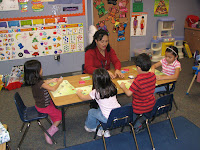 Do you know what “active” teaching is? If I told you “it’s the kind of teaching that makes learning palpable,” would that clarify things? If you’re thinking, “no, not really,” you’re not alone. “Active” teaching is an abstract concept. In order for it to make sense, we need to shift to the concrete.
Do you know what “active” teaching is? If I told you “it’s the kind of teaching that makes learning palpable,” would that clarify things? If you’re thinking, “no, not really,” you’re not alone. “Active” teaching is an abstract concept. In order for it to make sense, we need to shift to the concrete.
Today, my task was to teach a group of eighth graders how to write good beginnings for literary essays. Having been down this road before, I could anticipate the pitfalls:
- Too short
- Too detailed
- Summarizes everything into first paragraph
In the past, when students have fallen short of the goal of writing a “good” introductory paragraph, I’ve said things like, “Make sure it has a thesis statement,” or “You need to write more than this.” Like those of us confused by the term “active” teaching defined as “palpable learning,” feedback like this suffers the same fate. It means nothing because it is too abstract.
So instead of vague teaching, I focused on being concrete. In my mini lesson, I listed the criteria for a good beginning: Title of story, author, position being presented, at least 3-5 sentences, catchy. I showed them models of good beginnings and bad beginnings. Then I asked students to work together in small groups to craft a beginning for a response to a piece that we had recently read together.
And then the wrestle with words began.
One group’s first attempt went like this:
In the story In Your Hat by Ellen Conford, Dennis asked his crush, Ariel for help with his book report that was due the next day.
When I stopped by to confer with the group, I could see immediately that this group had slipped into the familiar routine of summarizing what had happened. Instead of saying, “This has too much summary, we walked to the front of the classroom where the models still sat and we studied them together. We puzzled through how what they had written compared to how the models were written and they noticed that the model began with a more general statement and then moved to the more specific thesis statement. They set back to work and their second attempt read like this:
In life, you get pranked. Either you get your underwear put up the flagpole or you get called for a fake order of Uggs from the 99 cent store. Neither are nice. You can either get back at the prankster or let it go. In Ellen Conford’s In Your Hat, Ariel, who had been pranked by Dennis, decided to get him back. And when she did, she went way too far.
This is a dramatic change that speaks volumes about the learning that transpired. In fact, one of the girls in the group even said, “Why did nobody ever tell me this before? I’ve been doing this the wrong way all these years and I never understood why.”
Little did she know, her teachers have been telling her, but in explaining how to do it better what they’ve really been saying is “active teaching is palpable learning.” If we want to reach students, we have to ask ourselves, “How can I teach this in a way that will reach my students?” The answer is in the handprint on the sidewalk: be concrete.







